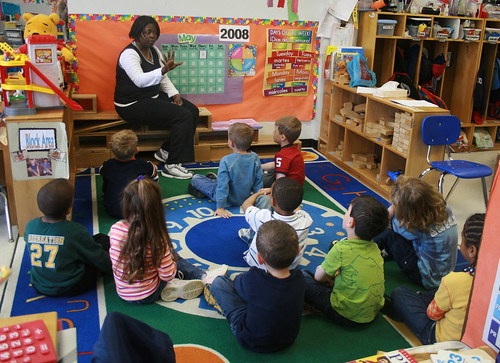This month’s featured article from ASAT is by Program Director of the Kansas City Autism Training Center Tanya Baynham, MS, BCBA, on a variety of research-based strategies to help you expand interests in children with autism. To learn more about ASAT, please visit their website at www.asatonline.org. You can also sign up for ASAT’s free newsletter, Science in Autism Treatment, and like them on Facebook!
My child is doing well with many of his ABA programs, even the ones that focus on the development of play skills. Unfortunately, he doesn’t play with most of the toys that we give him, and he has worked for the same five things since our program began a year ago (marshmallow peeps, Thomas trains, tickles, Wiggles songs, and raisins). What can I do to expand his interests and maybe even get those interests to function as reinforcers for teaching targets?
Answered by Tanya Baynham, MS, BCBA
Program Director, Kansas City Autism Training Center
Inherent to a diagnosis of autism is the observation that the child will engage in restricted or repetitive behavior and may also display restricted interests. Expanding those interests, specifically in the areas of toy use and play, is an important programming goal as it can result in a number of positive effects. First, rates of socially appropriate behaviors may increase while rates of inappropriate behaviors may decrease. For example, engaging a child in looking at a book may decrease stereotypic behaviors or passivity (Nuzzolo-Gomez, Leonard, Ortiz, Rivera, & Greer, 2002). Second, interest expansion can lead to new social opportunities for children and promote greater flexibility when bringing them to new environments. For example, a child with a new preference for coloring may be more successful in a restaurant because he will sit and color the menu, or he can attend Sunday school because he will color a picture when directed. Third, the addition of new reinforcers in ABA programs may help prevent satiation or allow you to allocate more highly preferred items for difficult teaching targets and less preferred items for easier targets.
Stocco, Thompson, and Rodriguez (2011) showed that teachers are likely to present fewer options to individuals with restricted interests and will allow them to engage longer with items associated with those restricted interests. The authors suggest one possible reason for this is that teachers might be sensitive to the fact that negative behaviors (e.g., whining, pushing the toy away) are more likely to accompany the presentation of a toy that is not associated with the child’s restricted interest. In general, this sensitivity to the child’s behavior is important in maintaining low rates of problem behavior, but it can potentially limit access to novel experiences or activities. We need to systematically program effective ways to expand a child’s interests without evoking tears and other negative behavior.
Most importantly we, as parents and intervention providers, must make reinforcer expansion a teaching focus and use data to determine whether our procedures are producing change. One recommendation is to first track the number of different toys and activities with which your child engages to identify current patterns. Then, measure the effects of attempts at reinforcer expansion on your child’s behavior. Ala’i-Rosales, Zeug, and Baynham (2008) suggested a variety of measures that can be helpful in determining whether your child’s world is expanding. These measures include the number of toys presented, number of different toys approached/contacted across a week (in and/or out of session), engagement duration with new toys, and affect while engaging with toys. It is sometimes helpful to track changes across specific categories (e.g., social activities, food, social toys, sensory toys, etc.). If, for example, your child only watches Thomas videos, you may narrow the focus to the category “videos” in order to track expansion of interests to different types of videos. Keeping in mind the previous point about a teacher’s role in expanding a child’s interests, you may also want to set goals to ensure changes in adult behavior such as, “Present three new items each day.”
Once data are being taken, it is important to implement procedures likely to expand your child’s interests. One way to expand toy play is to present, or pair, a preferred item with the item you want to become more preferred (Ardoin, Martens, Wolfe, Hilt and Rosenthal, 2004). Here are a few examples:
- Playing a game: Use peeps as the game pieces in a game you want your child to enjoy, embedding opportunities to eat the peeps at different points during the game.
- Trying a new activity: Sing a favorite song as you help your child up the ladder of an unfamiliar slide on the playground.
- Reading a book: Tickle your child before turning each page while reading a book.
A second way to expand interests is to think about why your child might engage in those restricted interests. If he likes Thomas because of the happy face, put Thomas stickers on a ring stacker. If he likes Thomas because of the wheels, present other vehicles with wheels. If your child likes peeps because they blow up in the microwave, put Mentos in a cola bottle or use baking soda to make a volcano. If he likes peeps because they are squishy, use marshmallows in art projects or in a match-by-feel game.
A third way to expand interests is described by Singer-Dudek, Oblak, and Greer (2011), who demonstrated that some children will engage more with a novel toy after simply observing another child receiving reinforcers after playing with it. To apply these findings to your child, give Thomas trains, if they are used as a reinforcer, to a sibling who just played with novel items such as play dough or shaving cream. Continue reading

 A major tenet of Applied Behavior Analysis is that it is evidence-based. For decades, our field has conducted research about behaviors we can observe in the environment, and worked to create positive behavior change. But keeping up with research or determining what is actually evidence-based can be quite challenging.
A major tenet of Applied Behavior Analysis is that it is evidence-based. For decades, our field has conducted research about behaviors we can observe in the environment, and worked to create positive behavior change. But keeping up with research or determining what is actually evidence-based can be quite challenging. Yes, sadly it can happen. With 400+ purported treatments for autism, there is no shortage of such whose name begins with an activity, substance, or favorite pastime and ends in the word “therapy.” A cursory internet search would reveal such “therapies” as music therapy, art therapy, play therapy, sand therapy, dolphin therapy, horseback riding therapy, bleach therapy, vitamin therapy, chelation therapy, and helminth worm therapy joining the list of the more established habilitative therapies such as physical therapy, occupational therapy, and speech-language therapy (this is by no means an exhaustive list of the array of “therapies” that are marketed to consumers). Touted therapies can involve all sorts of things. I recall sitting on a panel at Nova University in the late ‘90s with another provider boasting the benefits of llamas and lizards as well.
Yes, sadly it can happen. With 400+ purported treatments for autism, there is no shortage of such whose name begins with an activity, substance, or favorite pastime and ends in the word “therapy.” A cursory internet search would reveal such “therapies” as music therapy, art therapy, play therapy, sand therapy, dolphin therapy, horseback riding therapy, bleach therapy, vitamin therapy, chelation therapy, and helminth worm therapy joining the list of the more established habilitative therapies such as physical therapy, occupational therapy, and speech-language therapy (this is by no means an exhaustive list of the array of “therapies” that are marketed to consumers). Touted therapies can involve all sorts of things. I recall sitting on a panel at Nova University in the late ‘90s with another provider boasting the benefits of llamas and lizards as well. For example, let’s say Harold frequently won’t get up independently on weekdays before school. It’s driving his parents crazy, because they have to drag him out of bed several days a week. You may set up a DRH to increase the rate of him getting up independently. Since Harold currently gets up independently at least one time per week, you would set the goal for two times per week. (You don’t want to set the goal too high, because then Harold might not ever come into contact with reinforcement, and his behavior will likely remain unchanged.) Let Harold know that if he gets up independently two days in a row, you will make his favorite breakfast on the second day. Once Harold has met this goal a few time, increase the requirement for reinforcement. You would move from two days in a row to three days in a row in order to receive his favorite breakfast.
For example, let’s say Harold frequently won’t get up independently on weekdays before school. It’s driving his parents crazy, because they have to drag him out of bed several days a week. You may set up a DRH to increase the rate of him getting up independently. Since Harold currently gets up independently at least one time per week, you would set the goal for two times per week. (You don’t want to set the goal too high, because then Harold might not ever come into contact with reinforcement, and his behavior will likely remain unchanged.) Let Harold know that if he gets up independently two days in a row, you will make his favorite breakfast on the second day. Once Harold has met this goal a few time, increase the requirement for reinforcement. You would move from two days in a row to three days in a row in order to receive his favorite breakfast. There are a few different ways to implement DRL. You might select a target number of times the behavior can be exhibited within a full session, then deliver reinforcement to the individual if they exhibit the behavior that number of times or less within the session. For example, Gina teaches in a preschool where they have a 5-minute circle time each morning. During circle time, a boy named Luke raises his hand constantly. Gina wants to reduce the number of times he raises his hand during circle time, but she does not want to eliminate the behavior altogether. She took some baseline data and discovered that he raised his hand approximately 12 times during each circle time. Gina decided that Luke would be allowed to go to the water table, (his favorite activity,) if he raised his hand 10 times or less during circle time. This is called a criterion limit. As his behavior decreased, she would decrease the number of times he was able to raise his hand in order to access reinforcement. Her goal was to get him down to 3 instances of raising his hand during the circle time activity. This procedure for DRL is useful in a classroom setting, because it does not require the teacher to take a lot of data or keep track of intervals, though that might be appropriate in other situations.
There are a few different ways to implement DRL. You might select a target number of times the behavior can be exhibited within a full session, then deliver reinforcement to the individual if they exhibit the behavior that number of times or less within the session. For example, Gina teaches in a preschool where they have a 5-minute circle time each morning. During circle time, a boy named Luke raises his hand constantly. Gina wants to reduce the number of times he raises his hand during circle time, but she does not want to eliminate the behavior altogether. She took some baseline data and discovered that he raised his hand approximately 12 times during each circle time. Gina decided that Luke would be allowed to go to the water table, (his favorite activity,) if he raised his hand 10 times or less during circle time. This is called a criterion limit. As his behavior decreased, she would decrease the number of times he was able to raise his hand in order to access reinforcement. Her goal was to get him down to 3 instances of raising his hand during the circle time activity. This procedure for DRL is useful in a classroom setting, because it does not require the teacher to take a lot of data or keep track of intervals, though that might be appropriate in other situations. DRA is “a procedure for decreasing problem behavior in which reinforcement is delivered for a behavior that serves as a desirable alternative to the behavior targeted for reduction and withheld following instances of the problem behavior (e.g., reinforcing completion of academic worksheet items when the behavior targeted for reduction is talk-outs)” (Cooper, Heron, & Heward, 2007). The key thing to remember here is if you are implementing a DRA, a specified alternative behavior has been selected for reinforcement.
DRA is “a procedure for decreasing problem behavior in which reinforcement is delivered for a behavior that serves as a desirable alternative to the behavior targeted for reduction and withheld following instances of the problem behavior (e.g., reinforcing completion of academic worksheet items when the behavior targeted for reduction is talk-outs)” (Cooper, Heron, & Heward, 2007). The key thing to remember here is if you are implementing a DRA, a specified alternative behavior has been selected for reinforcement. DRI is not always the best option. For example, it may be very challenging to come up with an incompatible behavior. Or, in the case of self-injurious or aggressive behavior, it may be dangerous to use such an intervention.
DRI is not always the best option. For example, it may be very challenging to come up with an incompatible behavior. Or, in the case of self-injurious or aggressive behavior, it may be dangerous to use such an intervention.

 Often, we focus on how to improve the behavior of an individual, but there are many times in which teachers must figure out a way to improve the behavior of the entire class. In ABA, we might implement a group contingency, a strategy in which reinforcement for the whole group is based upon the behavior of one or more people within the group meeting a performance criterion (Cooper, Heron, & Heward, 2007).
Often, we focus on how to improve the behavior of an individual, but there are many times in which teachers must figure out a way to improve the behavior of the entire class. In ABA, we might implement a group contingency, a strategy in which reinforcement for the whole group is based upon the behavior of one or more people within the group meeting a performance criterion (Cooper, Heron, & Heward, 2007).